Tom's Hardware Verdict
The Lenovo Yoga 7i makes the most of its i5 chip, outperforming even i7 competitors at times. It’s also affordable and has a great keyboard, but some people may not be able to look past its reflective screen and tinny audio.
Pros
- +
Strong performance
- +
Affordable
- +
Comfortable keyboard
- +
Long battery life
Cons
- -
Dim, reflective screen
- -
Tinny audio
- -
Webcam doesn’t capture color well
Why you can trust Tom's Hardware
So far, we’ve reviewed two Tiger Lake convertibles, both of which have Intel Core i7 CPUs, which means we’re ready to change gears with a more budget-oriented model. Enter the Lenovo Yoga 7i, which is the latest in Lenovo’s more consumer-oriented Yoga convertible series.
This laptop packs an Intel Core i5-1135G7 CPU and seeks to bring some of the conveniences buyers would expect from ThinkPads - like the keyboard and webcam cover - to a wider audience. But can it stack up to its beefier cousins or any of the best ultrabooks and premium laptops?
Lenovo Yoga 7i Specifications
| CPU | Intel Core i5-1135G7 |
| Graphics | Intel Iris Xe Graphics |
| Memory | 12GB DDR4-3200 |
| Storage | 512 GB M.2 2242 SSD |
| Display | 14.4 inches, IPS, 1920 x 1080, 60Hz |
| Networking | 802.11ax Wi-Fi 6, Bluetooth 5.0 |
| Ports | Thunderbolt 4 x 2, USB Type-A 3.2 Gen 1 x 1, 3.5mm Combo Microphone/Headphone Jack |
| Camera | 720p |
| Battery | 71 Wh |
| Power Adapter | 65W |
| Operating System | Windows 10 Home |
| Dimensions(WxDxH) | 12.61 x 8.45 x 0.62 inches |
| Weight | 3.1 pounds |
| Price (as configured) | $899 |
Design of the Lenovo Yoga 7i


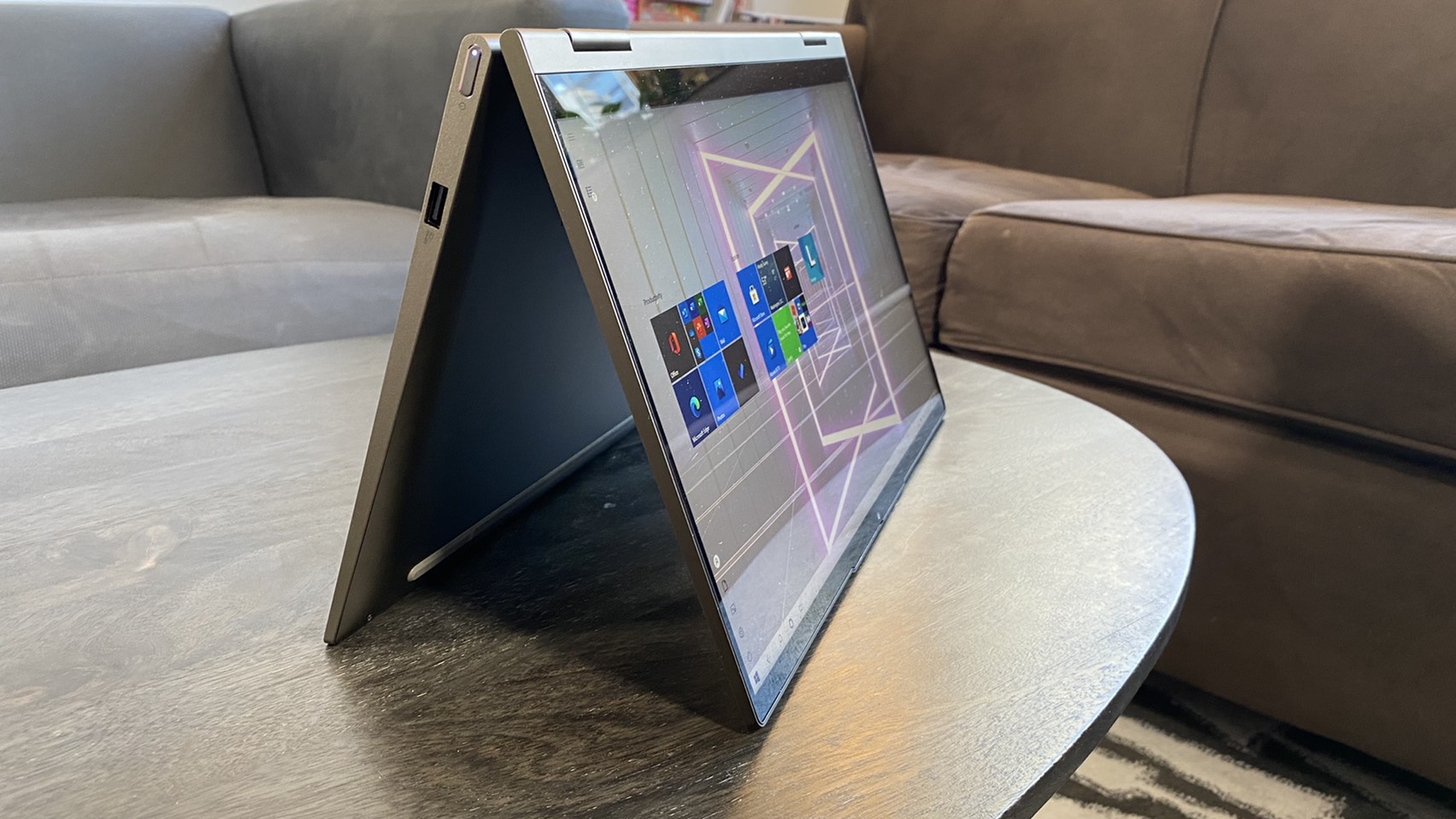


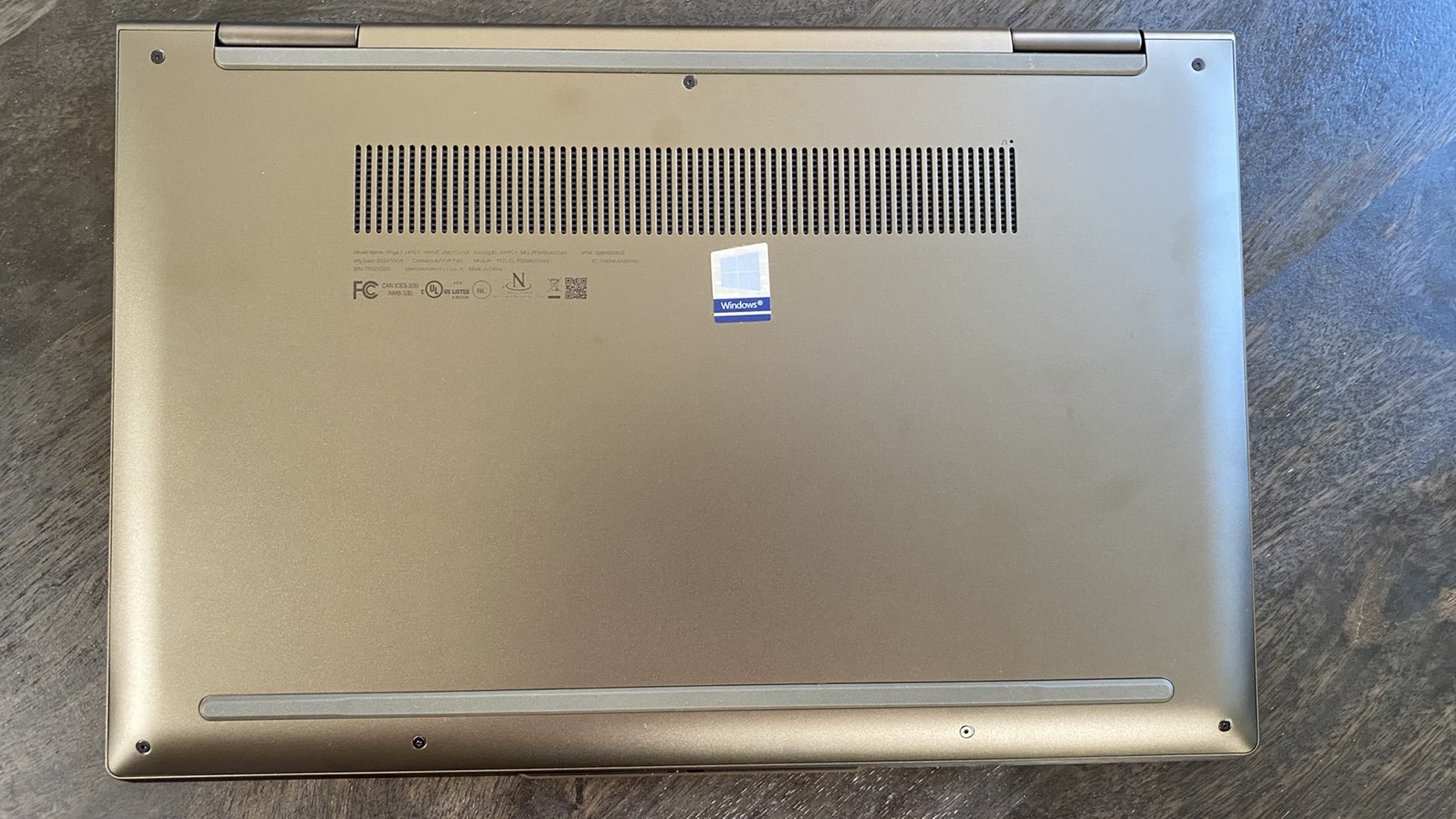
The Lenovo Yoga 7i is marginally heavier and larger than other recent ultraportables from competitors such as Dell and Asus, offers little in the way of ports, and is visually inoffensive but somewhat bland.
The Yoga 7i is encased in a brownish-gray (you can also choose a dark green option) aluminum shell that feels sturdy in the hand but tends to pick up fingerprints. The Yoga and Lenovo logos adorn the outside of the laptop’s lid, and opening the machine reveals more of the same.
In a nice touch, the keyboard matches the case’s color, though the screen’s bezels are surprisingly thick, measuring between a quarter of an inch to almost half of an inch depending on which side you’re looking at. The Lenovo Logo is also on the Yoga’s inside, tastefully rounding out the bottom-right corner thanks to its metallic silver plating.
The review unit we tested was 12.6 x 8.4 x 0.6 inches, though other configurations might differ in height, getting as tall as 0.7 inches. Given that Dell’s recent XPS 13 2-in-1 is only 11.7 x 8.2 x 0.6 inches and Asus Zenbook Flip S is just 12 x 8.3 x 0.6 inches, that makes this convertible potentially thicker than some other 2-in-1s. Microsoft’s Surface Laptop Go ultraportable is even smaller, at 11 x 8.1 x 0.6 inches.
The Yoga 7i is also heavier than rivals, coming in at 3.1 pounds. The XPS 13 2-in-1 is 2.9 pounds, by comparison, while the Zenbook Flip S is 2.7 pounds and the Surface Laptop Go is just 2.5 pounds.
We’d hope that this small touch of extra size would let Lenovo add more ports to the Yoga, but this laptop is also short on connections. The laptop’s left side has just 2 Thunderbolt 4 ports and a single 3.5mm combination headphone/microphone jack, while the right side is home to a sole USB Type-A 3.2 Gen 1 port.
Like many convertible 2-in-1s, the power button on the Yoga 7i is also on the laptop’s right side and activates with a single press, so you’ll want to be careful not to accidentally hit it during use.
Productivity Performance of the Lenovo Yoga 7i
The Yoga 7i is the first machine we’ve tested with an Intel Core i5 Tiger Lake chip. In particular, our configuration came with an Intel Core i5-1135G7 chip, which includes integrated Intel Iris Xe Graphics. Our config also had 12GB of DDR4-3200 memory, which is an unusual amount, and a 512GB SSD.
By comparison, other recent Tiger Lake convertibles we’ve reviewed have all had Intel Core i7-1165G7 chips. These include the Dell XPS 13 2-in-1 and the Asus Zenbook Flip S, which outprice the Yoga by several hundred dollars. We wanted to see how well the i5 stacked up to the i7, so we kept these machines in the test pool, but we also rounded out our benchmarking with the Microsoft Surface Laptop Go, a similarly priced ultraportable laptop with an Intel Core i5-1035G1, a 10th Gen "Ice Lake" chip.
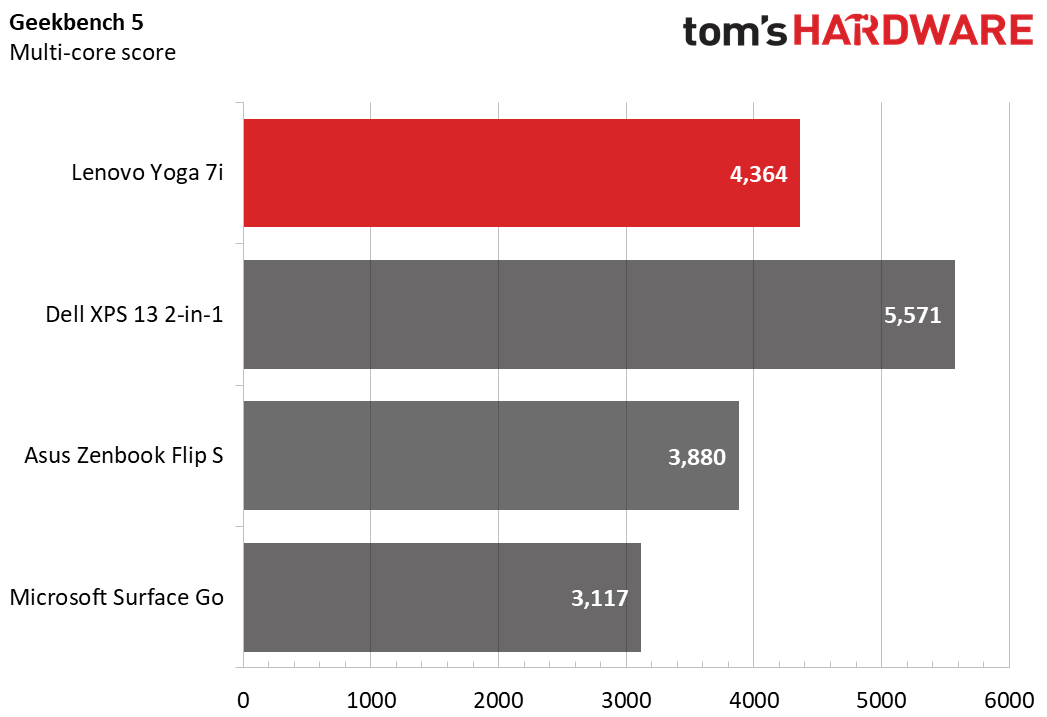
In our Geekbench 5.0 benchmark, which tests overall performance, the i5 proved that it’s capable of outperforming the i7 in the right machine. The Yoga scored 4,364 points on multi-core performance, which outpaced the Ice Lake Surface Laptop Go’s 3,117 points and even the Zenbook Flip S’ 3,880 points. This, and the test results below, could be due to better cooling on the Yoga. Still, the XPS 13 2-in-1 scored 5,571 points, demonstrating how much higher the i7’s peak is compared to the i5’s.
Get Tom's Hardware's best news and in-depth reviews, straight to your inbox.
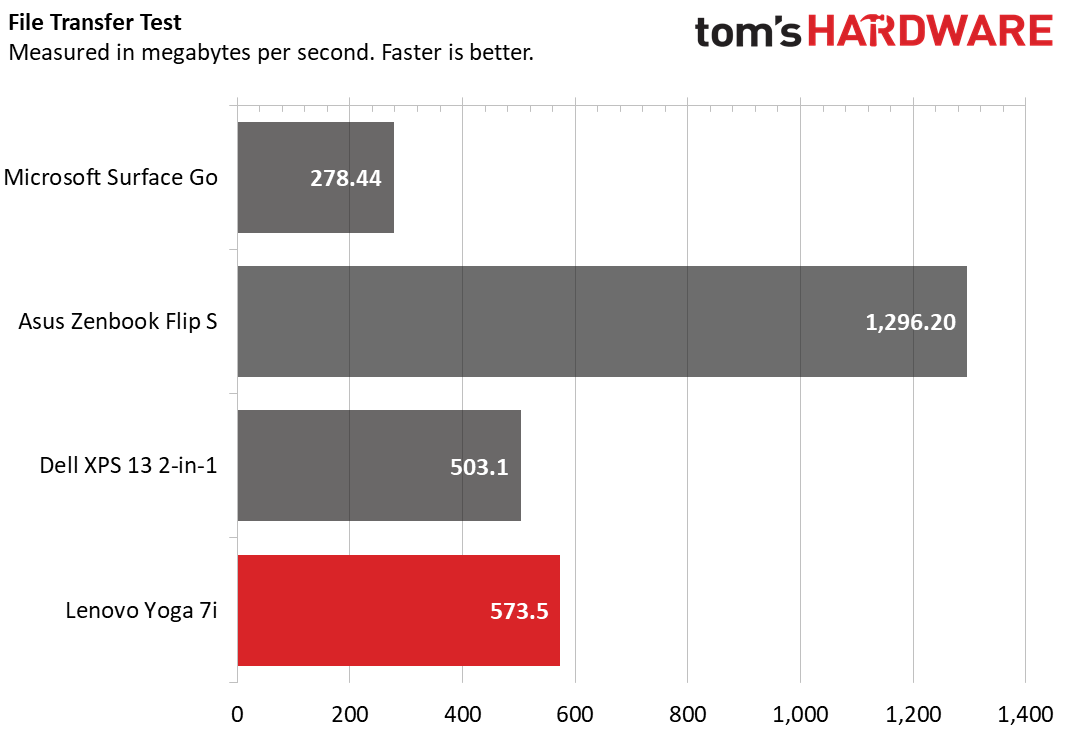
In our file transfer test , which tracks how quickly a computer copies 4.97GB of files, the Yoga 7i hit speeds of 573.5 MBps. That put it in second place behind the Zenbook Flip S’ 1,296 MBps and above the XPS 13 2-in-1’s 503.1 MBps. The Surface Laptop Go was the slowest machine here, with a file transfer speed of just 278.4 MBps.
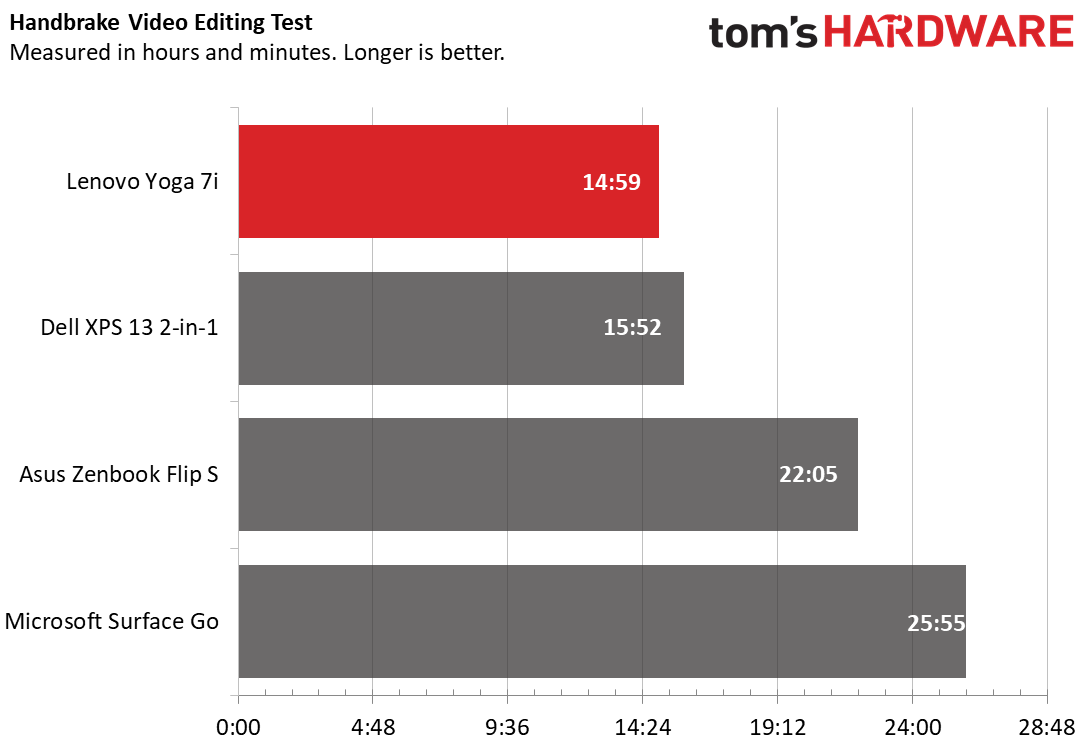
The Yoga 7i also came in first place in video transcoding. In our Handbrake benchmark, which tracks how long it takes a computer to transcode a video down from 4K to FHD, the Yoga 7i finished the task in 14:59. The XPS 13 2-in-1 took 15:52 to finish the task, by comparison, while the ZenBook Flip S completed transcoding in 22:05 and the Surface Laptop Go did the same in 25:55.
So far, that’s impressive performance for a mid-range chip. However, we also wanted to test how the Yoga holds up with Intel’s Iris Xe graphics. Here, it stumbled a bit more than in previous benchmarks. In 3DMark Fire Strike, the Yoga 7i scored just 2,025 points, which put it well above the Surface Laptop Go’s 1,229 points but far short of its Core i7-powered peers. The Zenbook Flip S scored 3,351 points on this benchmark, while the XPS 13 2-in-1 earned 3,847 points.
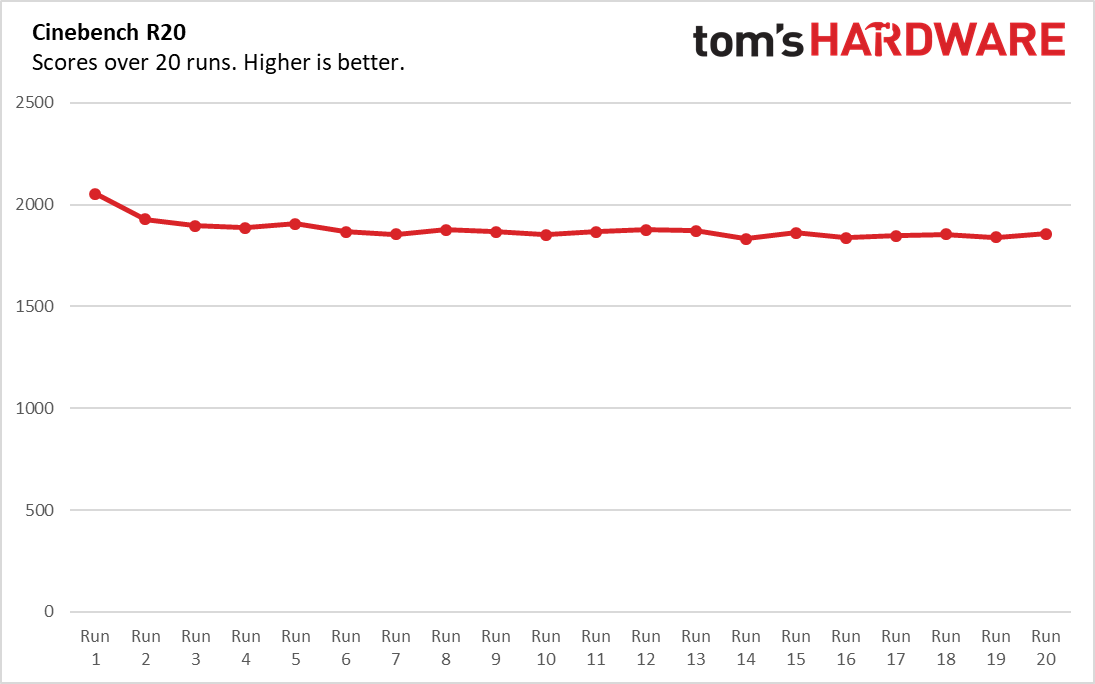
We also put the Yoga 7i through a Cinebench R20 stress test, to see how well it performs under repeated strain. We ran Cinebench R20 on a loop 20 times in a row, and while the tests began with scores around 2,053 and 1,926, they quickly fell to an average score around 1,876.5.
During the Cinebench stress test, the Yoga 7i’s CPU ran at an average clock speed of 2.95 GHz and at an average temperature of 69.7 degrees Celsius.
We’re impressed by how well the Yoga 7i kept pace with i7 convertibles, which might be due to the slightly larger chassis and improved cooling letting its chip stretch its legs more.
Display on the Lenovo Yoga 7i
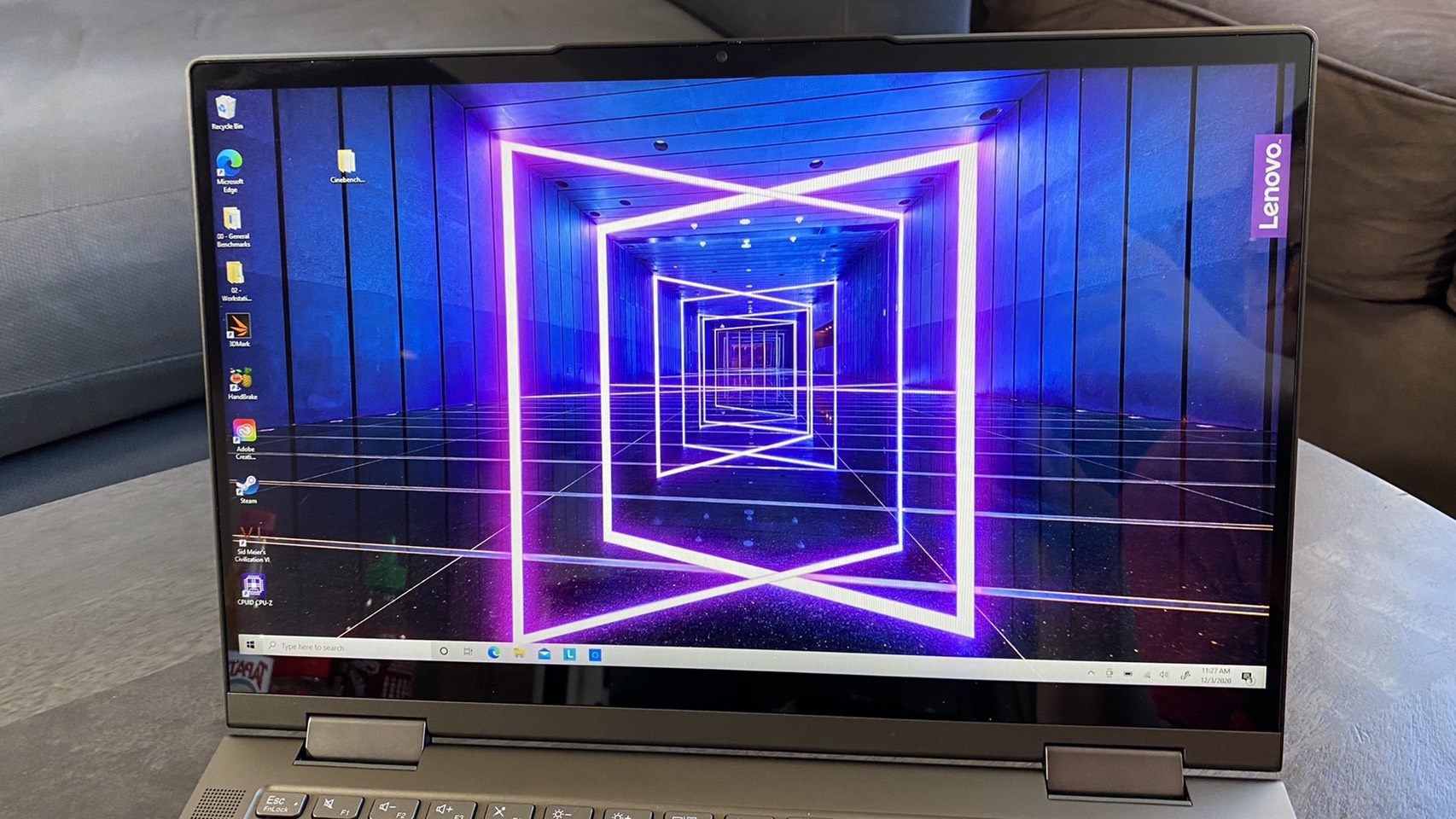
The Lenovo Yoga 7i config we tested came with a 14.4 inch IPS touchscreen, though anecdotal testing left it feeling more like a cheaper LED display.
To test out the Yoga 7i’s screen, I watched the trailer for season 2 of The Mandalorian in both normal and low light. Colors were vivid, but blacks also lacked depth. This was most noticeable during space scenes, where ship thrusters tended to cause artifacting and pixelated halo effects that weren’t present on my other displays. But what was most damning was how reflective the screen was. Even in low light, I had difficulty finding positions where my own reflection wasn’t visible. This also affected viewing angles, which didn’t stretch beyond 45 degrees on either side due to reflections.
The reflectivity might be due in part to a low max brightness, which our tests found topped out at a 266 nits average. That’s far lower than the 375 nits average you’ll find on the Zenbook Flip S, and even further below the 488 nits average on the XPS 13 2-in-1. The Microsoft Surface Go (which has a sub-1080p 1536 x 1024 resolution) is also brighter, at a 319.4 nits average.
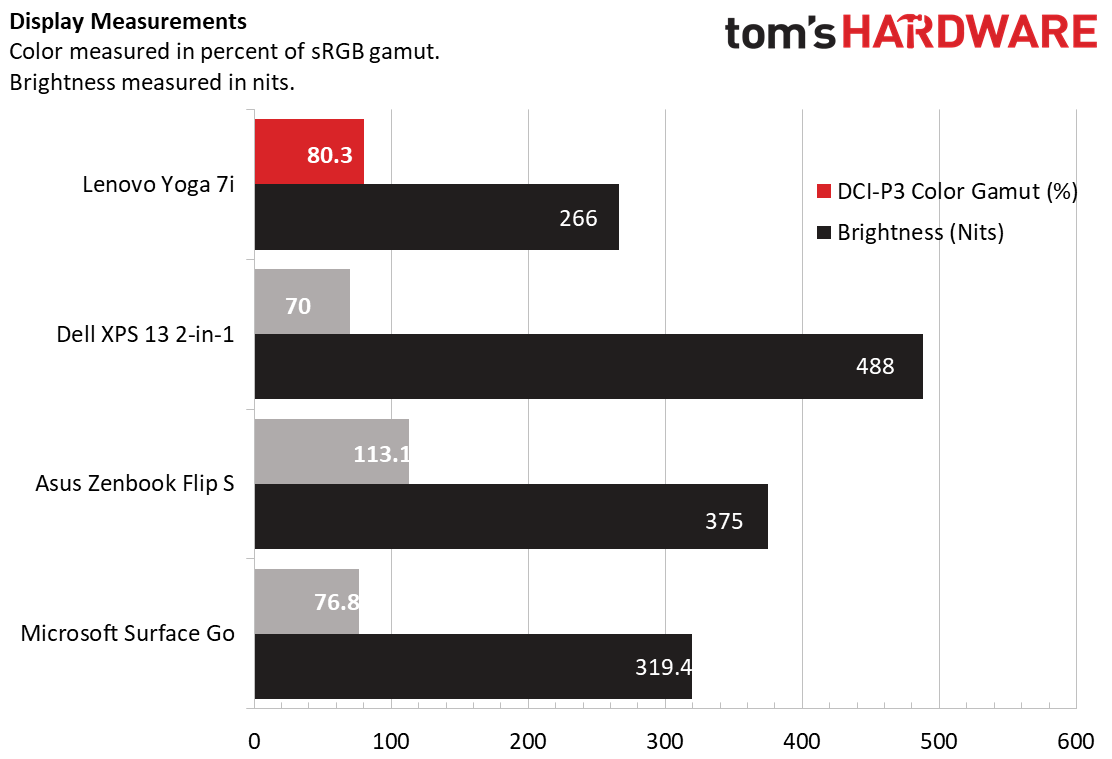
The Yoga 7i fared well on colors compared to rivals, however. Our colorimeter measured that it covered 80.3% of the DCI-P3 spectrum, while the XPS 13 2-in-1 reached only 70% and the Surface Laptop Go captured 76.8%. The Zenbook Flip S took top marks here, though, with 113.1% DCI-P3 coverage.
Keyboard and Touchpad on the Lenovo Yoga 7i

Aside from their flat surface, the Yoga 7i’s keycaps have the same unique curved bottom shape as what you’ll find on a ThinkPad, which not only looks slick but also gives your fingers more grip when navigating the keyboard. This made touch-typing easy, and I regularly scored 80 words per minute on 10fastfingers.com, which is my average.
During these typing tests, I found the travel distance to be comfortable and felt cushiony rather than bottoming out.
In contrast to its excellent keyboard, the Yoga’s precision touchpad felt lacking. While it registered multitouch input well and had a comfortable amount of friction, its small footprint made it feel cramped. When making large, sweeping motions across the laptop’s whole screen, I usually had to lift my finger off the touchpad a few times to finish.
Audio on the Lenovo Yoga 7i
The Lenovo Yoga 7i has two top-firing Dolby Atmos speakers on either side of its keyboard that can get loud and surprisingly bassy, but also have an issue with tinny vocals and melodies.
I tested the Yoga 7i’s audio with Life Goes On by BTS, which has a good mix of vocals, high-pitched melodies, drum beats and general bass. On max volume, the song easily carried across my two-bedroom apartment and even through doors, and I had to lower the laptop to around 30% volume for comfortable listening. Bass was surprisingly legible during this listening experience, which is rare for laptops, and I was impressed to notice what sounded like surround sound on a recurring clicky sound throughout the song, with the Yoga 7i making it sound like it came from different source areas than the rest of the music.
The 7i wasn’t as impressive on vocals and higher-pitched sounds, though. While these were perfectly understandable, they were also weak and sounded somewhat metallic and tinny. This was more of an aftertaste than the whole experience, but it did make the song physically grating after a few replays.
Upgradeability of the Lenovo Yoga 7i

We opened the Yoga 7i by removing the 7 Torx screws along the bottom of its case with a T5 Torx screwdriver and simply lifting the case off. Once inside, we found that we had access to the SSD and the networking chip, but the RAM was soldered in.
The SSD is also in a unique M.2 2242 format, which means it’s 22 mm wide and 42 mm long. That said, the slot appears to have space for drives up to M.2 2280. We’ve reached out to Lenovo for comment on this and will update this review once we get more confirmation.
Battery Life of the Lenovo Yoga 7i
Our battery testing exceeded expecations. The Yoga 7i proved ready for all-day work with a battery life of 12:36.
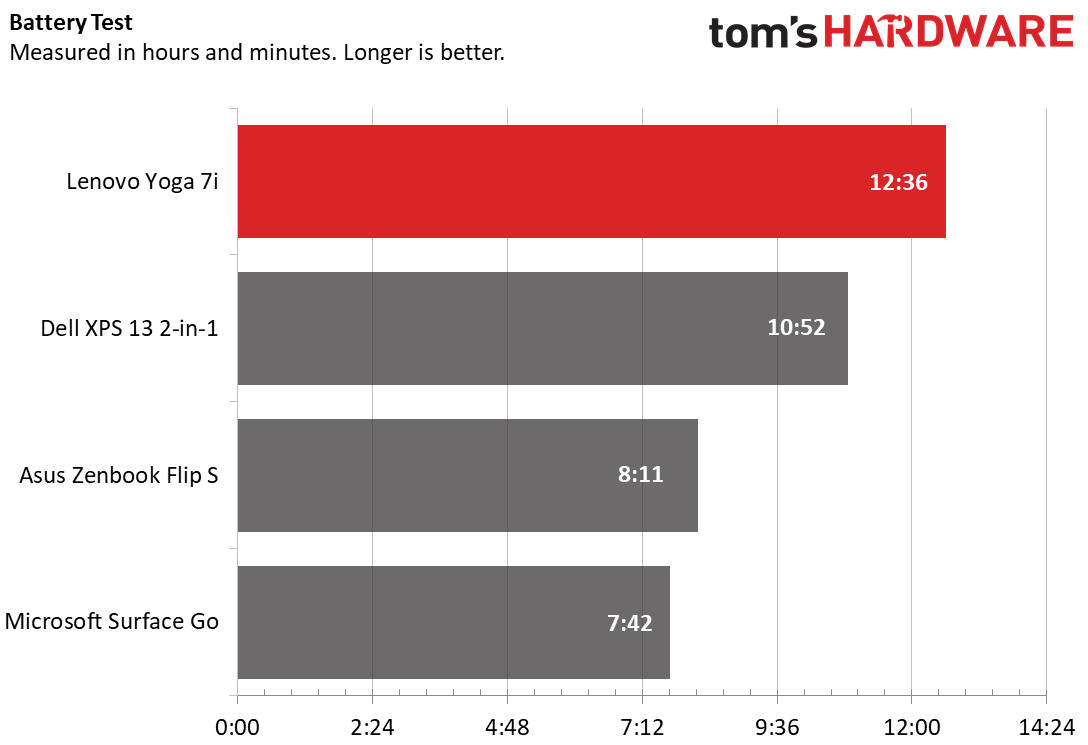
Our battery life benchmark continually browses the web, streams video and runs OpenGL tests over Wi-Fi at 150 nits of brightness, to attempt to simulate an average user’s typical use cases. The Zenbook Flip S was the only Yoga rival we tested to exceed it on battery, hitting 13:47 of life. The Dell XPS 13 9310 fell short of it with 10:52 of life, while the Microsoft Surface Go laptop had just 7:42 of life.
Heat on the Lenovo Yoga 7i
Since it’s a convertible and is meant to be held while in use, strong heat management is a must for the Yoga 7i. In our testing, we found that it was more than comfortable to the touch.
After we streamed 15 minutes of YouTube, we found that the touchpad was the coolest location, measuring just 77.5 degrees Fahrenheit (25.3 degrees Celsius). This jumped up to 84.5 degrees Fahrenheit (29.2 degrees Celsius) on the laptop’s bottom and 87.5 degrees Fahrenheit (30.8 degrees Celsius) on the laptop’s keyboard. The hottest area on the Yoga 7i was just above the f7 key, where the laptop hit 93 degrees (33.9 degrees).
All of this is negligible in use, and on par with temperatures from the XPS 13 2-in-1.
Webcam on the Lenovo Yoga 7i
The Lenovo Yoga 7i borrows the physical webcam cover from ThinkPad lineup, but despite this extra feature, the Yoga 7i’s webcam comes across like an afterthought.
While it reproduces texture well and has very little grain to it despite being 720p, the webcam has issues with reproducing color. In particular, it tended to make me look gray and somewhat undead in selfies, and I also had difficulty lighting my shots despite how well-lit my environment was.
You might want to go for one of our best webcams contenders instead.
Software and Warranty on the Lenovo Yoga 7i
Like most Lenovo machines, the Yoga 7i is mercifully light on pre-installed software. We did remove McAfee Livesafe before we began benchmarking, as this can affect performance, but all the other pre-installed software either comes as part of Windows (Microsoft Solitaire Collection) or is useful for utility.
Dolby Atmos and Dolby Vision both come pre-installed on the Yoga 7i, and let you adjust various video and audio profiles to customize your media experience. Intel Graphics Command Center also fulfills a similar role, but the meat of the Yoga’s pre-installed software comes in Lenovo’s own apps.
Lenovo Vantage consolidates diagnostics, Wi-Fi security options, microphone and webcam settings, driver updates and the like into one convenient app, while Lenovo pen settings lets you adjust how the laptop reacts to a Lenovo pen (sold separately). Lenovo Utility, meanwhile, provides on-screen notifications that show whether caps lock or numlock are on and whether your computer is in laptop or tablet mode.
Lenovo Yoga 7i Configurations
The Lenovo Yoga 7i starts at $899 at Best Buy, which is the version we tested. This model comes with an Intel Core i5-1135G7 CPU, 12GB of DDR4-3200 RAM, a 512GB SSD and a 14.4 inch 1080p IPS touchscreen. Meanwhile, the $899 option at the Lenovo store has 8GB of RAM rather than 12GB and a 256GB SSD rather than 512GB.
Potential upgrades on Lenovo's site include bumping your processor up to an Intel Core i7-1165G7 for $150 more, bumping your RAM up to 16GB for $55 more and bumping your SSD up to 1TB for $125 more.
You can also change your color scheme to “dark moss,” which gives the computer a greenish tint, for no additional cost. All of these hardware upgrades put together would bump up the price for the machine to a still manageable $1,239.99.
Bottom Line

Despite the base model for the Lenovo Yoga 7i coming with a less powerful processor than the other Tiger Lake convertibles we’ve reviewed recently, it still keeps pace with them and sometimes beats them on a majority of tasks, all while costing less. The tradeoff here is, of course, a hit to features like the display, audio and webcam, as well as a mild increase in size.
The key draw to the 7i is, of course, its price. While the Dell XPS 13 2-in-1 9310 generally outperforms it, especially on graphics, the Yoga 7i is still close enough behind to make its $899 price tag look compelling next to the Core i7-powered XPS 13 2-in-1’s $1,650. And even when dropped to its i5 config, the XPS 13 2-in-1 is still $1,249. That said, if you want the best of the best performance and would like a brighter screen with clearer audio, the XPS 13 2-in-1 is still your best choice.
Meanwhile, if you want more vivid colors, the Zenbook Flip S is also an attractive buy. The screen isn’t as bright as the XPS but is still far brighter than what you’ll get on the Yoga, and the audio is arguably better than what you’ll find on the XPS thanks to bass boost software. Performance is more varied though, so keep that in mind when looking at its $1,449 price tag. But if you’re looking for a budget convertible that can go toe-to-toe with more premium models and don’t mind making some sacrifices on display and audio, the Lenovo Yoga 7i presents a tempting option.
Michelle Ehrhardt is an editor at Tom's Hardware. She's been following tech since her family got a Gateway running Windows 95, and is now on her third custom-built system. Her work has been published in publications like Paste, The Atlantic, and Kill Screen, just to name a few. She also holds a master's degree in game design from NYU.
-
bastula Great review! Saw this machine at Best Buy for sale and was wondering about the performance. Would be great to see a head to head with a Ryzen 4600u, 4650u or 4700u. I personally have the Yoga 6 with 4650u. Only thing it's missing I feel is TB4.Reply
One issue with the Handbrake test graph - legend says "longer is better" instead of "shorter is better." -
digitalw Replybastula said:...a head to head with a Ryzen 4600u, 4650u or 4700u. I personally have the Yoga 6 with 4650u.
As maybe you have noticed. TH realy is unbiased when comes Intel vs AMD arena. I dont want to say that Intel is THs sponsor but i got that feeling.
